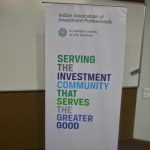- June 30, 2014
- Posted by: kunalsabnis
- Category:BLOG, Events, Mumbai, Speaker Events
Contributed by: Kunal Sabnis, CFA
Mumbai chapter of the IAIP conducted an event to discuss the growth drivers and road ahead for Indian Pharma sector at the S.P. Jain Institute of Management & Research on 27th June. The event had two esteemed speakers Prashant Nair, CFA, Deputy Head of India Equity Research for Citi and Senior Analyst covering the Indian Pharmaceutical, Healthcare and Agrochemical sectors and Dr. Rajesh Shivhare, an affiliate member of the CFA Institute who manages super-speciality dental practice with 15 years of vast experience.
Highlights of the event are as follows.
Dr. Rajesh Shivhare
Indian Pharma industry has 24,000 players with 300 from the organised sector. Top 10 companies account for more than a third of the market with acute therapy accounting for 70% of the revenues. Domestic companies have been focussing on developed markets which have been a source of higher growth in recent years. The most important aspects for a pharma analyst while analysing a company are,
- Scientific part – Understanding the medical and technical specialisation of the company. Its expertise in APIs, generics or branded formulations.
- Research and Development – Understanding the pipeline of R&D through medical applications and determining the stage of development it is at.
- Regulatory aspects – Understanding the alarm bells from the regulator.
Pharma sector is divided into Active pharmaceutical Ingredients (API) and Formulations. APIs are further divided into branded and generic whereas formulations are divided into therapeutic segments such as Chronic and Acute. R&D is the life blood of the industry and domestic companies have substantially increased their total investment in R&D over the last decade. The five stages a drug undergoes are Checking for Safety, Checking for efficacy, Confirming findings in large patient population, Testing long term safety and Commercialisation. With the amount of investment involved in R&D one single company doesn’t take the drug through all the stages.
While analysing a drug which a company is expected to launch, it is important to first analyse the market size of the therapy and then future growth should be factored in. Mostly companies overestimate the market size and their expected revenues but independent analysis should be done. Breakthrough/blockbuster drugs are generally characterised by larger market size and lower competition which can fetch significant profits. A company with even a one such drug can considerably change its earnings trajectory. A company should have a blend of innovative (high market potential) drugs and drugs that act by established mechanisms of action to reduce the risk.
Prashant Nair, CFA
Indian Pharma market size was $16.4bn in FY13 which is 2% of the global market size but 4th largest in volume terms. Indian companies have a 73% market share. Cheaper cost of land and labour along with sops from the government have kept the cost of production low and made India an attractive destination for pharmaceutical manufacturing. Moreover India has a superior chemistry capability supporting the constant demand for R&D.
Domestic players have started small but have moved up the value chain and evolved into global companies. They have mainly started by selling APIs in semi-regulated markets through reverse engineering and then moved on to selling APIs in regulated markets along with formulations in semi-regulated markets. Then they have moved on to build front-end expertise in the regulated markets for selling formulations. Many domestic companies have achieved this feat and more moved on to limited competition products, novel drugs and complex R&D products.
US is the largest market (patented – $350bn and generic – $55bn) and has higher competition but is still a good growth driver for Indian companies even as they are constantly expanding into other emerging markets. Many Indian companies are focussing superior generics and complex injectables for higher value generation. But recently USFDA actions have been very disruptive for the Indian companies but increased vigilance is going to enhance the quality of process and products which will benefit the companies and domestic consumers over the longer term. Generic companies have been unable to crack the Japanese market since the Japanese believe that generic versions are of an inferior quality to patented formulations.
The event concluded with a Q&A sessions and was well received by a participatory audience.
– K S
























